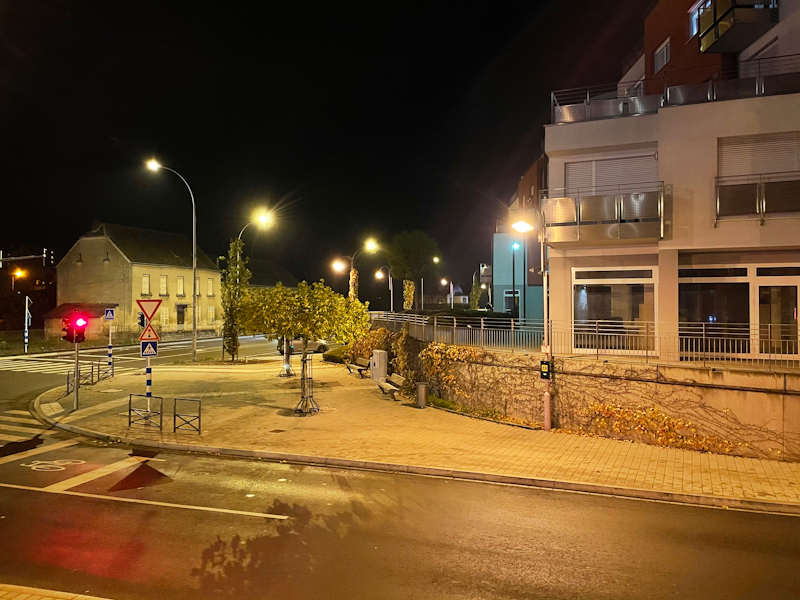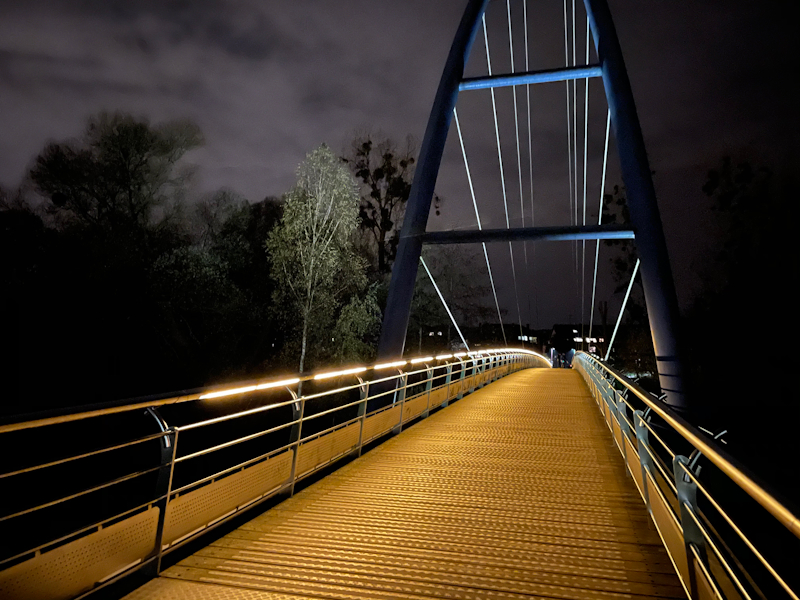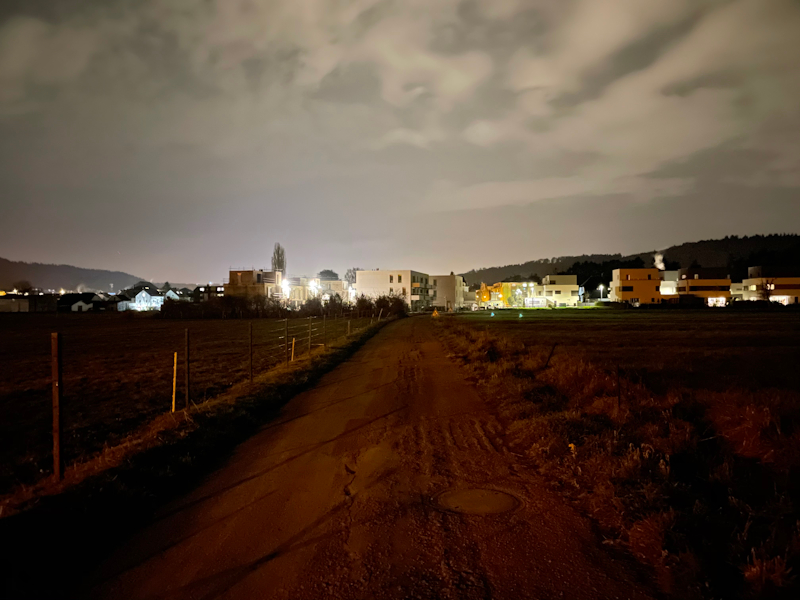The iPhone 12 & 12 Pro Review: New Design and Diminishing Returns
by Andrei Frumusanu on November 30, 2020 8:30 AM EST- Posted in
- Mobile
- Apple
- Smartphones
- Apple A14
- iPhone 12
- iPhone 12 Pro
Camera - Low Light Evaluation
Low-light capture on the iPhone 12’s should be improved for two reasons: First of all, the new f/1.6 lens of the main camera should allow for 27% better light capture compared to the f/1.8 unit of the iPhone 11’s. Secondly, Apple with this generation has finally addressed the lack of Night Mode on the ultra-wide and telephoto modules, resolving a quite huge handicap that was present on the iPhone 11 generation of devices.

[ iPhone 12 Pro ]
[ iPhone 11 Pro ]
[ Note20 Ultra (S) ]
[ S20+ (E) ]
[ Pixel 5 ] [ X-T30 ]
In this first scene, the results are actually a bit disappointing as we’re seeing almost no differences between the 12 Pro and the 11 Pro. The new phone uses half the exposure time according to the EXIF data, but has to use a higher ISO level to compensate. The only thing that’s noticeably better on the 12 Pro is the improved lens flare produced by the street light.
In general Apple’s Night Mode still doesn’t look to be as competitive as Google’s or Samsung’s implementation, as the S20, Note20 Ultra and the Pixel 5 perform quite better here.
On the ultra-wide angle, the inclusion of Night Mode now turns this camera module from something unusable to rather passable results. It’s a huge upgrade compared to the iPhone 11 series, but still lags behind the Pixel phone as far behind Samsung’s implementation.

[ iPhone 12 Pro ]
[ iPhone 11 Pro ]
[ Note20 Ultra (S) ]
[ S20+ (E) ]
[ Pixel 5 ] [ X-T30 ]
Night mode being fully automatically triggered on the iPhone’s camera, means there’s no way to force it on when there’s too much light, such as in this scene – which is really odd given that it did trigger on the iPhone 11 Pro, thus producing an overall better result than the 12 Pro.
The UWA again gains massive usability with the addition of Night Mode, although all the phones here produce quite bad results for a variety of different reasons.

[ iPhone 12 Pro ]
[ iPhone 11 Pro ]
[ Note20 Ultra (S) ]
[ S20+ (E) ]
[ Pixel 5 ] [ X-T30 ]
Here, the 12 Pro uses the larger aperture optics to reduce the ISO from 800 to 640. There’s a slight change in colours, but overall I wouldn’t say that it’s something that would be immediately noticeable between the two generation of phones.

[ iPhone 12 Pro ]
[ iPhone 11 Pro ]
[ Note20 Ultra (S) ]
[ S20+ (E) ]
[ Pixel 5 ] [ X-T30 ]
This scene was a bit odd for the two iPhones as they both showcased identical exposure times as well as ISO levels, although the iPhone 12 Pro shot is brighter due to the larger aperture. The phone didn’t trigger Night Mode for this shot as it was too bright.
Night Mode for the UWA is a large jump for the iPhone 12, but it can’t compete against the Samsung devices or the Pixel phone, although the latter got the colour temperature completely wrong.

[ iPhone 12 Pro ] [ iPhone 11 Pro ]
[ Note20 Ultra (S) ] [ S20+ (E) ]
[ Pixel 5 ] [ X-T30 ]
Here again the iPhone 12 Pro uses the larger aperture in order to reduce the ISO levels of the shot, which is a bit odd given that I feel that the iPhone 11 Pro had the sharper and less noisy shot. There’s also a change in colour temperature although saying which is better is subjective.

[ iPhone 12 Pro ] [ iPhone 11 Pro ]
[ Note20 Ultra (S) ] [ S20+ (E) ]
[ Pixel 5 ] [ X-T30 ]
Finally, in an extreme low-light shot I’m simply challenging the light capture abilities of the cameras here. This scene was extremely dark and the first sample shot of the Fuji is likely better representation of the scene as experienced in-person, while the EV+2 shot is closer to the exposure the phones are trying to achieve.
Neither of the phones are faring well here, and the iPhone 12 Pro does change a bit of the tone-mapping compared to the iPhone 11 Pro, faring a bit better, although I feel the Samsung phones are producing a more natural look.
Low-Light Conclusion: Improved, but not Competitive
In general, I feel that Apple may have overpromised a bit on the part of the low-light capture ability of these new phones. While we do notice the larger aperture optics of the new modules in the resulting captures, Apple doesn’t seem to have substantially changed their Night Mode processing this year as sometimes it’s very hard to distinguish the iPhone 12 from the iPhone 11 results.
On the ultra-wide angle, the new Night Mode options obviously transforms previously unusable results into something that’s more passable. I feel that this shouldn’t be taken as praise versus Apple finally addressing a huge feature lack in the iPhone 11 series, as they were the only devices on the market actually lacking this functionality on the ultra-wide modules.
Although the results have improved, Apple here still largely lags behind the competition which sports better hardware, and also has been able to iterate on their computational photography modes over the past year.
It’s a pity that Apple chose to only employ a larger improved camera sensor on the iPhone 12 Pro Max, creating model differentiation on the cameras that previously didn’t exist – I would have had at least wished the 12 Pro to also house this improved sensor, if possible.










101 Comments
View All Comments
anshelanancy - Wednesday, December 2, 2020 - link
This iPhone 12 is really well designed but high cost and released in some countries normally we can buy it online. I want to buy this but it isn't released in my country. I must buy this phone but this time I am so much busy with my office work https://accountancyseekers.co.uk/ here doing work as a marketing executive since 2017.Byte - Tuesday, December 15, 2020 - link
I kept my X to play games on and found it hurts to hold the X now because the the whole side feels sharp now. Am i weird?Laga Goteborg - Thursday, June 24, 2021 - link
iPhone 12 LCD screens are much tougher than before, we had cases that glass was intact but LCD under glass was shattered. However we could always fix the problem via https://www.LagaiPhone.se/KPOM - Monday, November 30, 2020 - link
The 12 mini hits the sweet spot for design and features this year, and I’m surprised it isn’t selling better (apparently Apple is seeing more demand than expected for the Pro and Max and somewhat less for the 12 and mini).I agree that the 12 Pro is a bit heavy and the new design isn’t as easy to hold as the 11 Pro. But the mini is only slightly bigger than the original iPhone SE/5/5s, and is the most comfortable phone to hold that I’ve seen in years.
Bob Todd - Monday, November 30, 2020 - link
I assume some of it is just that people have gotten accustomed to gargantuan phones over time and it can be a bit of a shock to scale back down. After holding the 12 mini in one hand and my OnePlus 6 in the other, I was certainly hesitant to give up that much screen. It was mostly fond memories of my Essential Phone's form factor that pushed me to choose the mini. My wife on the other hand is eyeing the regular 12 for this exact reason. She's accustomed to the size of her OnePlus 7T and the progressively larger phones that have landed her there.lmcd - Tuesday, December 1, 2020 - link
I personally think that it's due to upgrade cycle timing -- why buy a 12 mini if you just bought an SE 2020?I think a lot of people in that niche picked up an SE and also are already the type to hold onto their phones longer.
techconc - Monday, December 7, 2020 - link
Agreed. I have the 12 Pro, but after feeling the 12 mini in my hand (and in my pocket), I think I may go mini next time.ikjadoon - Monday, November 30, 2020 - link
The Mini is limited to 12W peak MagSafe, unlike “up to 15W” on all the other models.https://support.apple.com/en-us/HT211829
Jetcat3 - Monday, November 30, 2020 - link
12W peak with a 2227 mAh cell is non issue in my opinion.Andrei, in your testing did you notice increased black levels with low APL’s at brightness levels between 0-40%?
ikjadoon - Monday, November 30, 2020 - link
I don't think a single person genuinely cares or notices peak charging rates: minutes at best? Though the first page chart is a little incorrect.On displays, I'd be much more interested in power consumption of the two panels, so we can compare with the 11 Pro.